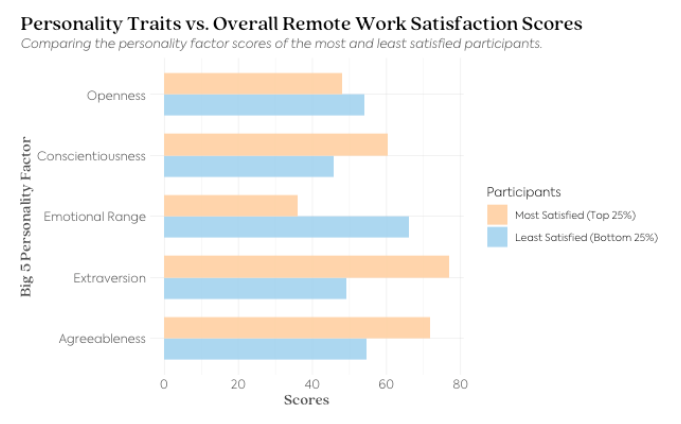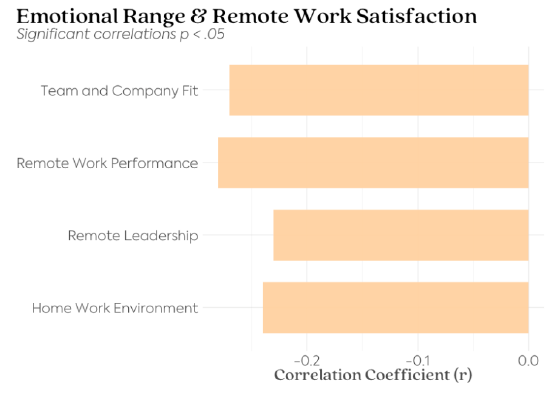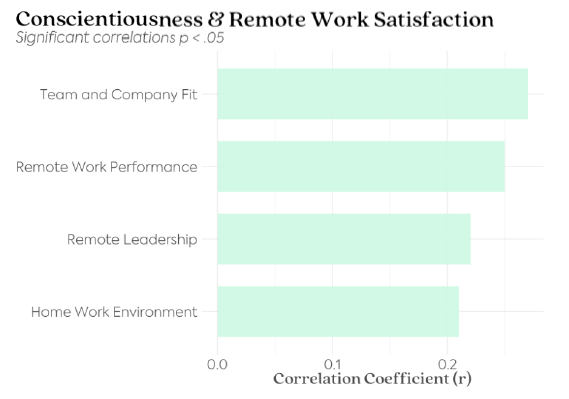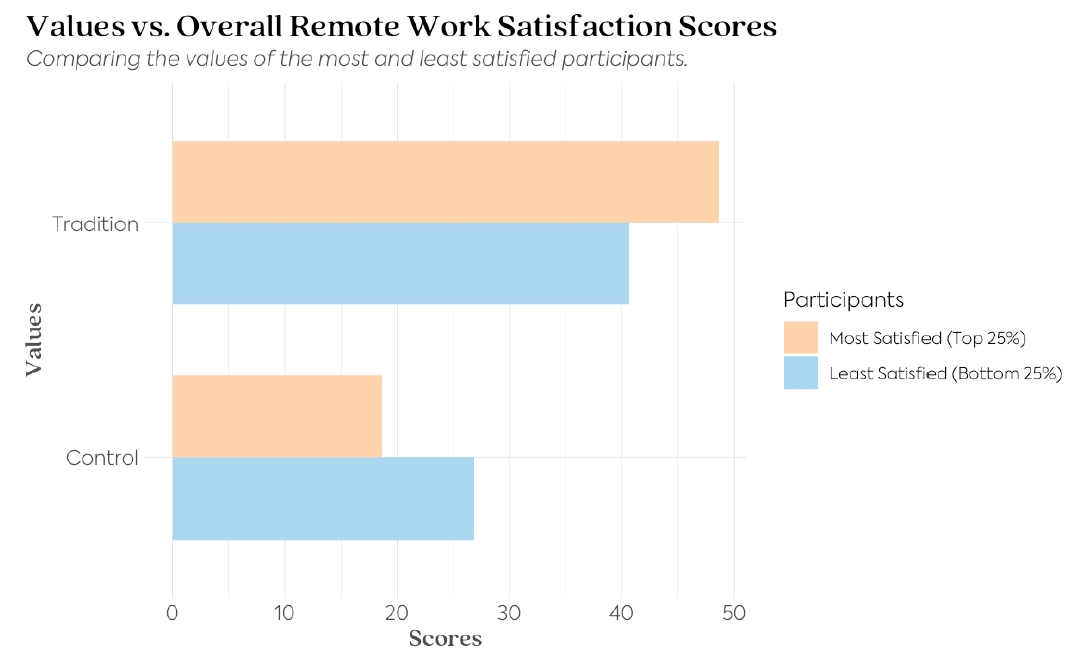What analysing 500 remote workers taught us - original data
We teamed up with a global consulting and digital transformation provider for a large-scale case study to better understand the effects of remote work for companies and their employees. This is what we found.
Ott Niggulis
Past studies have shown that when remote work is implemented strategically, it boosts productivity and employee satisfaction. The sudden changes posed by a global pandemic was anything but planned, and thus, it posed potential challenges for employees and managers alike.
Our aim was to investigate correlations between personality traits, core motivators, competencies, and the ability to adjust to a remote working model globally. Employees from around the world took part and enabled us to show tangible differences between countries and locations.
Methodology
This section covers the surveys and frameworks used in the case study. Skip to the “Results” section below to see the analysed results.
The following insights are based on four surveys on work satisfaction and behavioural characteristics related to remote work adjustment and its relationship with validated constructs for workplace competencies, personality traits, and motivators.
The case study used the Wisnio talent analytics platform to assess workplace competencies, personality traits, and motivators. Additionally, a 12-question remote work satisfaction survey was used to get company-specific information.
To learn more about Wisnio and how we can help you build high performing teams, sign-up for a free account here.
Remote Work Satisfaction Survey
Participants were asked 12 questions regarding their satisfaction with personal productivity, managerial support and recognition, development opportunities, work-life balance, and having the tools and knowledge of expectations they need to work remotely. These scores were assessed using a 6-point Likert scale and adjusted to a comparable score of 0 to 100 for each item.
Big 5 Personality Framework
Costa and McCrae developed the Big 5 Personality model based on their research throughout the 1970s. Since the publication of their seminal work in 1987, their model has been used on millions of subjects, consistently demonstrating high construct validity and test-retest reliability across cultures, age, and gender (McCrae & John, 1992)*.
Wisnio uses the updated IPIP NEO framework, measuring six facets or dimensions for Extraversion, Conscientiousness, Emotional Range (ER), Agreeableness, and Openness. Each facet is measured by a total of four questions using a 6-point Likert scale. These scores are normalised to a percentile value for each personality factor on a scale of 0 to 100.
Schwartz Theory of Universal Values
According to Schwartz et al.'s (2012)** refined values theory, values relate to goals and ideals that transcend specific actions and situations. Despite being universal, the degree to which individuals care about each value varies, forming a unique hierarchical value system.
Schwartz's value constructs have been supported across 80 countries since the publication of their seminal work on the subject in 1987. Wisnio uses a 6-point Likert scale of items derived from widely cited academic research to assess an individual's ranking for each value, resulting in a score of 0 to 100 for each value.
Competence at Work
Spencer and Spencer (1993)*** defined competencies as behaviours or thought processes that lead to superior job performance. Based on their research, Wisnio's Competency Survey asks users to select and rank nine out of a total of twenty validated professional competencies.
“Using the Competency map, it became pretty clear pretty quickly on where the team is in terms of competency and who is bringing what to team along with potential team and personal development areas.”
Christoph Grandpierre - Managing Partner, Metakomm
Results
Overall, the results show that teams adjusted well to remote work with average scores ranging between 69 - 90 across individual items (a score of 100 indicates participants were very satisfied).
While this clearly indicates a positive overall adjustment to remote work conditions, there were a few notable differences when looking at relative scores by position, seniority level, region, and function.
The analysis and results are based on 500 participating employees from all leadership levels, job titles, business functions, and geographical regions around the world.
Remote work survey
The data shows clear differences between regions, business functions, and job titles. Employees in the same country or even office can have very different experiences depending on their business function and job title.
NB: Results from the remote work survey are based on one company and are specific to them only. These cannot be generalised for all companies. To get an accurate understanding, each company needs to analyse and survey their own employees.
- The analysis showed significant differences between business functions, job roles, and regions. For example, apart from The US & Canada (70% extremely satisfied), all other regions showed modest to low satisfaction with remote work.
- The groups most impacted (negatively) by remote work were senior leadership and client-facing roles. Personal productivity took the biggest hit - 42% of participants in HR and Recruitment and 36% in Marketing and Growth showed dissatisfaction with personal productivity.
- With leadership, senior leaders showed the least satisfaction with the team and company, while the most junior leaders were most satisfied. This indicates that front-line managers have adjusted well and are able to manage and motivate employees effectively, whereas higher-level managers struggle to keep their direct reports engaged.
Personality, values, and competencies

Satisfaction with a remote work environment is not only impacted by objective, physical characteristics of the workplace, but also by specific personality traits of an individual.
Analysing the deep-level characteristics (personality, values, competencies) of employees provides insights into the possible reasons why some people strive, and others struggle with adjusting to a remote work environment.
Emotional range

Our analysis showed the most significant differentiator for remote work satisfaction was the score for Emotional Range - the ability to remain calm and balanced. More specifically, Anxiety or how the feeling of uncertainty impacts participants.
With any sudden change comes inherent risks and anxiety surrounding the future of the business and personal job security. How employees deal with uncertain and stressful situations largely determines their satisfaction with remote work.
Conscientiousness

The second significant effect we identified was from the scores of Conscientiousness (acting in an organised and goal-oriented way). Particularly its facet of Self-Discipline.
This is perhaps not surprising - more organised and methodical people are better able to motivate themselves and thus maintain a healthy routine and schedule while working from home.
Control and Tradition

Additionally, there were significant differences between participants that value Control and Tradition.
Scores for Tradition were higher among participants satisfied with remote work based on a comparison of average scores. These individuals tend to commit to accepted norms and respect traditionally held ideas, and seek organisations with a strong culture. A positive correlation between valuing Tradition and team and company satisfaction also reflects this.
People who value Control work better in roles and environments where they can direct situations and influence others. Remote work settings make it more challenging to lead groups, and scores for this value correlate negatively with personal productivity, followed by satisfaction with the team and company.
Recommendations
- Understand regional and job function differences
Analyse remote work effectiveness across your organisation. As the devil is in the details, split the data between regions and job functions to get an accurate picture of how remote work affects work across the organisation.
The next time you have to switch to remote work, you’ll be able to better manage and minimize the impact on productivity and engagement by having a tailored-made plan for each region and job function.
- Use behavioural interviewing techniques
Consider checking for behavioural characteristics in your interviewing and evaluation process. This helps in understanding if the candidates have the skills and personality traits required to succeed in a remote work environment.
We recommend evaluating candidates on Emotional Range and Conscientiousness, particularly the facet of Self-Discipline. Both of these characteristics were strong predictors of high performance and job satisfaction when working in a remote setting. - Manage uncertainty and anxiety
In a rapidly changing environment, one of the main reasons for reduced engagement is uncertainty and anxiety about the future. To combat this, make sure that leadership is communicating openly and often to provide a sense of clarity and security to employees who struggle the most. Encouraging leaders to provide frequent positive feedback also helps in dealing with uncertainty and anxiety. - Have clear goals and frequent feedback
Having clear and measurable goals and frequent feedback often creates a supportive environment that softens external pressures to perform. This especially helps employees struggling with feeling equipped and capable of working effectively from home perform better.
Conclusions
Work satisfaction, remote work included, is a complicated subject and there are real differences between teams and roles based in different countries around the world.
What works in one part of the world (or country) is not guaranteed to work in another. People are different, and their challenges are different depending on a plethora of other factors. All this has to be taken into account.
While the differences can be significant, using talent analytics and data can be the first step in unlocking these differences and making adjustments as needed.
Going forward, companies can use the gathered and analysed talent data to make better position and location dependent hiring decisions. Today the challenge is remote work, tomorrow it could be something else. With actionable talent data, organisations can be better prepared for whatever happens next.
To learn more about Wisnio and how we can help you build high performing teams, sign-up for a free account here.
___________________
* McCrae, R. R., & John, O. P. (1992). An introduction to the five‐factor model and its applications. Journal of personality, 60(2), 175-215.
** Schwartz, S. H., et al. (2012). Refining the Theory of Basic Individual Values. Journal of personality and social psychology.
*** Spencer, L.M., & Spencer, S.M. (1993). “Competence at Work: Model for superior Performance”, Human Resource Development Quarterly Vol. 5, Issue 4, pp 391-395.